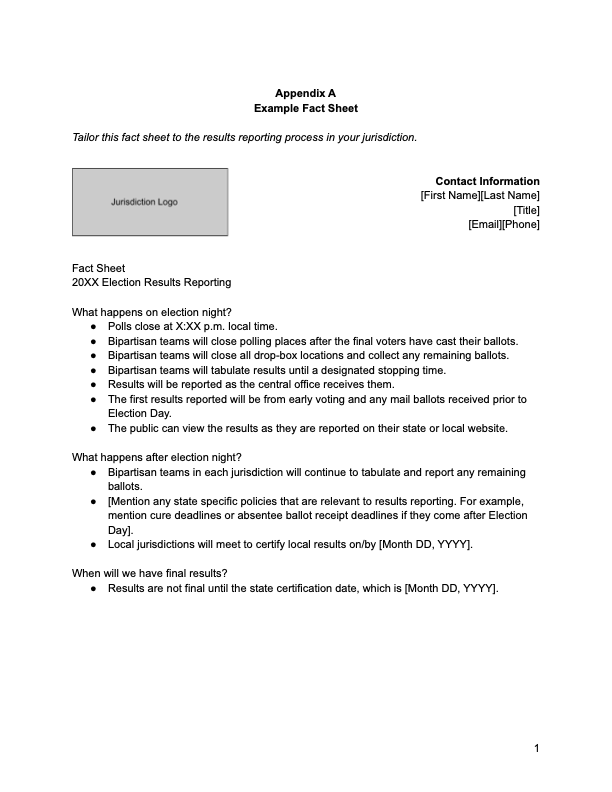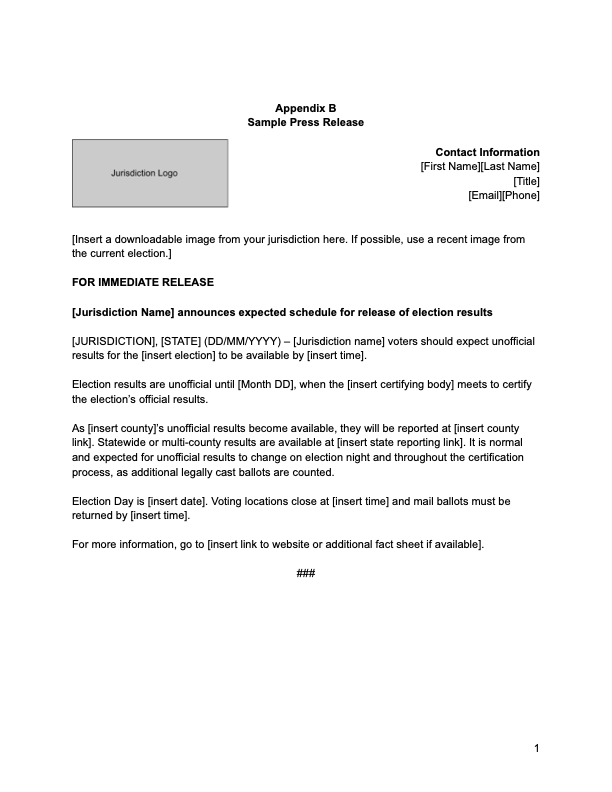November 3, 2022
4 Tips for Communicating About Election Results Reporting
Election officials know that reporting election results takes time, but the general public may not.
The following tips are designed to help you set public expectations by communicating when election results will be released and why they might change in the hours and days after the polls close.
The Appendix contains an example fact sheet and an example press release.
Tips
- Manage the public’s expectations
- Brief the media before Election Day
- Provide frequent updates
- Face challenges head on
Tip 1: Manage the public’s expectations
Before Election Day, communicate across all media, including social media, your relevant dates and terminology:
-
The polls close at ___ p.m. on November [day], [year] and the certification meeting is scheduled for November [day], [year]. During that time, all results are unofficial.
-
Unofficial county results will be posted at [insert URL]. For statewide results, visit [insert URL].
-
As more ballots are counted, results can and likely will change, which is normal and expected. Many ballots are not counted until after Election Day, including military and overseas ballots, provisional ballots or ballots requiring signature curing.
…
-
Tabulating all of the ballots takes time. Our plan is to be completed with tabulation by [date].
-
Our local election results are not finalized until [insert name of certifying body, e.g. Board of Supervisors] meets on November [day], [year]
-
Election results are then certified on [date] by the [Secretary of State / State Board of Elections / Election Commission] and official results for the state will be posted at that time
The first three suggestions work best when used before Election Day, while the others are better used after Election Day and through the date of canvassing or certification. If you plan to stop counting on election night and continue counting the following day, communicate that early.
Share this information with media contacts and community partners.
Tip 2: Brief the Media Before Election Day
Consider holding an off-the-record or on background media briefing prior to the election that addresses the information discussed in this guide.
Be prepared to answer questions about the following topics even if you didn’t include them in your briefing:
-
What happens if there is a recount? How are recounts initiated? Tip: If recounts are triggered by a formula, have the rules ready at your fingertips.
-
Can a candidate or voter request a recount? If a recount is requested, who pays for it?
-
If a recount occurs, what happens if the results are different?
-
What is an election challenge or contest and when can that be filed?
-
What audits take place before the canvass or certification?
Additionally, remember these important tips about planning for your media briefing:
-
Select a meaningful location. Try to avoid spaces with poor lighting or sound quality.
-
Make a clear, concise, prepared statement about results reporting. The fact sheet in Appendix A (below) can help you draft your statement.
-
Announce a start and stop time, introduce speakers, and establish whether a question and answer session will take place.
-
Adhere to your own start and stop times. Alert reporters of the last question, and before leaving thank everyone for their time.
Tip 3: Provide Frequent Updates
Create and publish a plan for how often you will post results updates. On election night, this may be hourly or at a different frequent, predetermined interval.
On the days after Election Day, will you do one or more updates a day? Making your plan public and sticking as closely as possible to the schedule helps promote confidence in the process.
Establish and share early whether or what time you plan to stop counting on election night.
For state offices, it might be useful to explain your state’s deadlines and tabulation procedures:
-
Do all ballots have to be received by the close of polls on Election Day? Or does your state accept postmarked ballots for some period of time after Election Day?
-
Does your state allow pre-processing of absentee or mail ballots?
-
Are there any post-election audits that are completed as a matter of course before certification?
Tip 4: Face Challenges Head On
Unmet expectations can create public angst. Elections are run by humans – mistakes happen – but systems are in place to correct any issues. Be transparent about mistakes, and explain how they were or will be addressed. This is why election results are unofficial until all of the post-election checks and balances have been completed. If you must report something unexpected to the public:
-
It is most important to communicate what actions you are taking to investigate and correct any issue.
-
When possible, explain how you discovered the issue or discrepancy. This is an opportunity to explain that checks and balances (many required by state laws and regulations) exist for this very purpose – that is, to ensure that the election results are accurate. Consider using The Election Group’s Crisis Communications Planning Guide to develop templates ahead of time.
-
The public values transparency and bipartisanship in all relevant election processes, and highlighting such oversight can be comforting.
If you do have a close contest or potential recount, you may wish to determine on election night the estimated number of outstanding ballots that still need to be counted, delineated by whether they are mail or provisional ballots, outstanding precinct votes, or ballots waiting to be cured. Be clear that not all outstanding ballots will be counted, such as provisional or absentee ballots waiting to be cured.
If your jurisdiction is one in which ballots can be received and counted later so long as they are postmarked by Election Day, be sure to explain that the estimate is based on past elections and is not exact.
Appendix
Appendix A: Sample Fact Sheet
Add relevant results reporting information, including what to expect regarding election night reporting, what happens after election night and final results information.
Download: Appendix A

Appendix B: Sample Press Release
Download and fill in the template. For additional guidance, see How To Write an Elections Press Release.
Download: Appendix B




